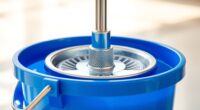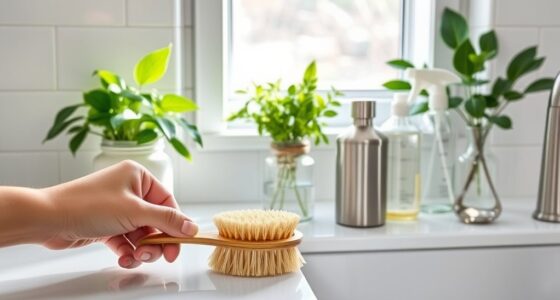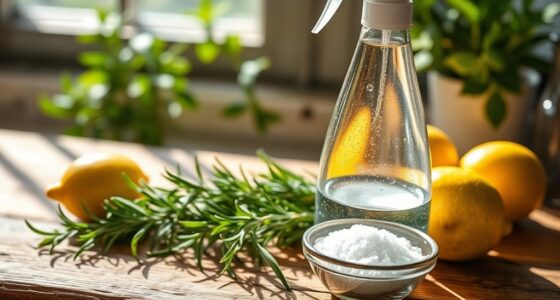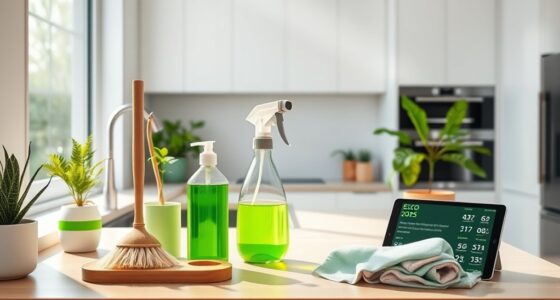To determine if your cleaner is truly ‘green,’ check for official eco certifications like USDA Organic or EcoLogo on the label; these indicate proven environmental standards. Look closely at the ingredients list to guarantee full transparency and avoid vague terms like “fragrance” or “proprietary blend,” which can hide harmful chemicals. Be skeptical of marketing claims and trust verified labels. If you want to ensure your cleaner aligns with your eco-conscious goals, there’s more to learn.
Key Takeaways
- Look for official eco-friendly certifications like USDA Organic, EPA Safer Choice, or EcoLogo as proof of environmental standards.
- Verify that labels clearly disclose all ingredients rather than vague terms like “fragrance” or “proprietary blend.”
- Check ingredient lists for harmful chemicals such as phthalates, ammonia, or chlorine to ensure safety.
- Be cautious of eco claims without certification; trusted labels are backed by specific testing and standards.
- Use both certification labels and ingredient transparency to choose cleaners that are truly greener and safer.

Cleaning product labels provide essential information to help you use products safely and effectively. When you pick up a cleaner, it’s tempting to focus only on the brand or scent, but reading the label thoroughly reveals whether the product aligns with your eco-friendly values. One key aspect to look for is eco friendly certifications. These symbols or labels, such as USDA Organic, EPA Safer Choice, or EcoLogo, indicate that the product has met specific environmental standards. They can help you identify cleaners that are designed to reduce environmental impact, contain fewer harmful chemicals, and promote sustainability. However, keep in mind that not all eco friendly claims are backed by certifications, so it’s wise to verify the authenticity of these labels.
Another critical element to contemplate is chemical ingredient transparency. A reputable cleaning product label clearly lists all ingredients used in the formulation, allowing you to understand what’s in the cleaner. This transparency is essential because many cleaning products contain undisclosed chemicals that could be harmful to your health or the environment. When ingredients are listed, you can check for potentially toxic substances like phthalates, ammonia, or chlorine. If the label simply states “fragrance” or “proprietary blend,” it’s a red flag that the manufacturer isn’t being fully transparent. Opting for products that openly disclose their ingredients gives you better control over what you’re exposing yourself, your family, and the planet to.
Additionally, understanding the HEPA filtration technology used in air purifiers can help you select the most effective products for allergen removal and improved air quality. Reading labels with these points in mind turns you into a more conscious consumer. You don’t have to be an expert in chemistry to make smarter choices; just pay attention to the eco friendly certifications and ingredient transparency. Certifications act as a shortcut, guiding you toward products that are better for the environment and safer for use around children and pets. Meanwhile, transparent ingredient lists empower you to avoid substances that might cause allergies or health issues. Combining these two factors makes it easier to determine whether a cleaner is genuinely ‘green’ or just marketing hype. Remember, a truly eco-friendly cleaner isn’t just about how it’s marketed—it’s about what’s inside and how it’s certified. By taking the time to read product labels carefully, you ensure your cleaning routine aligns with your values and health priorities, helping you create a safer, greener home.
Frequently Asked Questions
Are Natural Ingredients Always Eco-Friendly?
Natural ingredients aren’t always eco-friendly, so don’t assume they’re automatically safe for the environment. You need to look at labels carefully, as some natural substitutes may still contain chemicals or additives that aren’t eco friendly formulations. Always check for certifications and ingredient lists to guarantee your cleaning products truly align with green standards. This way, you’re making informed choices that support both your health and the planet.
Do Green Labels Guarantee Safety for Children and Pets?
Did you know that studies show nearly 60% of consumers trust green labels for safety? However, green labels don’t always guarantee safety for children and pets due to toxicity concerns. Certification reliability varies, so always check for reputable seals like USDA Organic or EPA Safer Choice. Don’t rely solely on labels—read ingredient lists carefully and opt for products with transparent, verified safety information to protect your loved ones effectively.
How Often Should I Replace My Cleaning Products?
You should replace your cleaning products based on their product shelf life, which varies by type and storage conditions. Check the expiration date on the label and discard any that are past this point to guarantee safety and effectiveness. Also, consider proper container disposal after use, especially for hazardous chemicals. Regular replacement helps prevent using expired or potentially unsafe products, keeping your home safer and cleaner.
Can I Trust Third-Party Certifications on Labels?
You might wonder if third-party certifications on cleaning product labels are trustworthy. While these labels can indicate good ingredient sourcing and certification credibility, they’re not foolproof. Always research the certifying organization to verify it maintains strict standards. Look for well-known eco-labels, and don’t rely solely on the badge—read the ingredient list to verify claims and make sure the product aligns with your green cleaning goals.
What Ingredients Should I Avoid in Green Cleaning Products?
Did you know that many cleaning products contain ingredients linked to health risks? You should avoid phthalates, which pose toxicity concerns, and steer clear of artificial fragrances that can trigger allergies. By reading labels carefully, you can protect yourself and your family. Choose products with natural ingredients, and always verify certifications. Staying informed helps you make safer, greener choices every time you clean.
Conclusion
Now that you know how to read cleaning product labels, you can make smarter choices and avoid being caught off guard. Remember, don’t judge a book by its cover—look beyond the flashy claims and check the ingredients. By being a savvy shopper, you’re not just cleaning smarter, but also protecting your family and the environment. Stay vigilant, ask questions, and don’t let greenwashing fool you; knowledge is your best cleaning partner.










